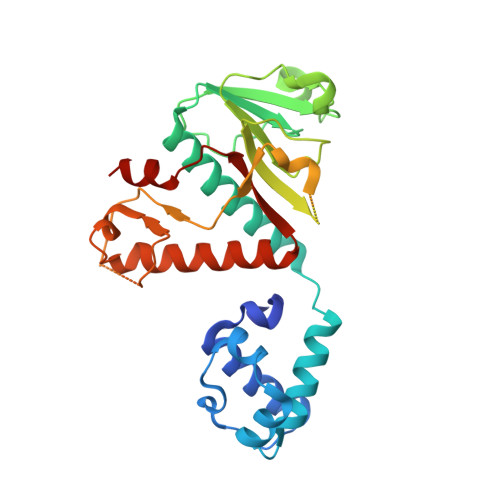Structures of SARS-CoV-2 N7-methyltransferase with DOT1L and PRMT7 inhibitors provide a platform for new antivirals.
Kottur, J., White, K.M., Rodriguez, M.L., Rechkoblit, O., Quintana-Feliciano, R., Nayar, A., Garcia-Sastre, A., Aggarwal, A.K.(2023) PLoS Pathog 19: e1011546-e1011546
- PubMed: 37523415
- DOI: https://doi.org/10.1371/journal.ppat.1011546
- Primary Citation of Related Structures:
8FRJ, 8FRK - PubMed Abstract:
The RNA N7-methyltransferase (MTase) activity of SARS-CoV-2's nsp14 protein is essential for viral replication and is a target for the development of new antivirals. Nsp14 uses S-adenosyl methionine (SAM) as the methyl donor to cap the 5' end of the SARS-CoV-2 mRNA and generates S-adenosyl homocysteine (SAH) as the reaction byproduct. Due to the central role of histone MTases in cancer, many SAM/SAH analogs with properties of cell permeability have recently been developed for the inhibition of these MTases. We have succeeded in identifying two such compounds (SGC0946 and SGC8158) that display significant antiviral activity and bind to the SARS-CoV-2 nsp14 N7-MTase core. Unexpectedly, crystal structures of SGC0946 and SGC8158 with the SARS-CoV-2 nsp14 N7-MTase core identify them as bi-substrate inhibitors of the viral MTase, co-occupying both the SAM and RNA binding sites; positing novel features that can be derivatized for increased potency and selectivity for SARS-CoV-2 nsp14. Taken together, the high-resolution structures and the accompanying biophysical and viral replication data provide a new avenue for developing analogs of SGC0946 and SGC8158 as antivirals.
Organizational Affiliation:
Department of Pharmacological Sciences, Icahn School of Medicine at Mount Sinai, New York, New York, United States of America.


















